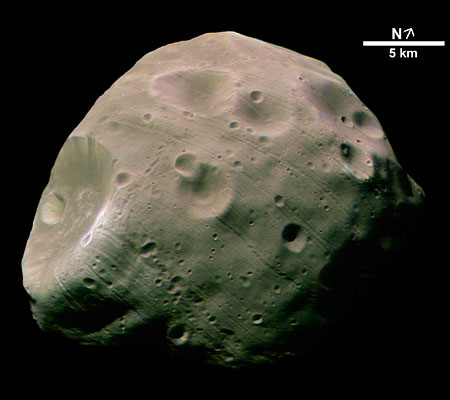This is evident from photographs and measurements made by the European Mars Express spacecraft.
Amit Oren

Direct link to this page: https://www.hayadan.org.il/phobos151104.html
Amit Oren, 15/11/2004
The European research spacecraft "Mars Express" took the most detailed picture of the reddish moon "Phobos".
This photo was taken from a distance of about 200 km from the moon with its unusual shape, and it shows the side facing the direction of Mars.
Scientists hope to explain the origin of the tracks that stretch across the moon from its equator to its north pole.
Phobos is slowly falling towards Mars and is expected to collide with it within a few million years.
Theories, mythology, and falling moons
Phobos (known from the ancient Greeks as "fear", hence also "phobia") is the largest of the two moons of Mars and its dimensions are about 27 km by about 19 km.
Its smaller counterpart, Deimos, is about half the size of Phobos and moves in a more distant orbit around Mars.
Phobos moves around Mars in a motion called a "Death Spiral", which means that the natural satellite will eventually crash into the planet.
It circles Mars three times a day, and is so close to its territory - that in certain places on Mars it will be possible to see it for a night from Mars, while on the same night in other places it will not be visible.
There are various theories about the origin of Phobos. One theory says that the satellite is an asteroid captured by the gravity of Mars, this is because this moon appears to be a C-type asteroid; A carbonaceous asteroid that is black in color.
But some scientists say there is evidence that Phobos and Deimos are byproducts of the breakup of a giant moon that once orbited Mars.
The image taken by "Mars Express" has a resolution of 7 meters per pixel.
Close-up on Phobos
Amit Oren. 21/11/2004
The article is based on a press release from the European Space Agency
This image (see above), taken by the high-resolution stereoscopic camera on the "Mars Express" spacecraft - a camera also called HRSC [High Resolution Stereo Camera], is the sharpest existing image of the reddish moon Phobos.
This image shows details that will keep planetary scientists enthralled and busy for years as they try to solve the mystery surrounding this moon. The image shows the side of the moon facing towards Mars, and was taken from a distance of less than 200 km with a resolution of about seven meters per pixel. The photo was taken during the 756th orbit of "Mars Express" around Mars.
Additional images of Phobos were taken at lower densities in previous orbits (the orbits: 413, 649, 682, 715 and 748). In the coming months, these images will be followed by additional images taken on subsequent passes near Phobos.
"Mars Express" periodically passes by Phobos about an hour before it passes over the surface of the Martian surface at an altitude of about 270 km - slightly above the Martian atmosphere. So that within minutes, the orbiting spacecraft turns away from Mars - and prepares its camera to point in the direction of Phobos.
The HRSC camera provided about ten images of the surface of Phobos, thus giving the researchers a lot of information and a penetrating view about the shape of the moon, its topography (land surface), its color, the light scattering form of the regolith material [Regolith - powdery material that covers most bodies the small and non-icy ones in the solar system. The regolith is formed by different effects on the same body], and the shape of the satellite's rotation and orbit (around Mars).
These images surpassed all their predecessors from all previous missions, by continuously covering the various areas of Phobos, and by achieving sharper results than ever before. The US Viking Orbiter also photographed a number of smaller areas of the satellite with an even higher resolution, but due to the spacecraft's fast and too close passage, the images did not come out sharp enough.
The main thing that can be noticed in the picture is the "rail network" that covers the reddish moon from its equator to its north pole. There is roughly a fixed distance between each rail. It is possible that now it will be possible to determine whether these tracks existed before the craters on the satellite were formed, and therefore - do they also exist in the deeper layers of Phobos? Or, did the tracks come as a result of the formation of the craters themselves?
More details are seen in the craters of their different types and sizes, which reflect light in a very different way from one another. Certain craters hold dark materials near their floors, others have regolith that has flowed over the walls of the crater, and others have dark emission from them - material believed to be among the darkest materials in our solar system.
It is believed that the small moon is in a "death spiral", meaning; slowly approaching Mars. Phobos was found to be about five kilometers beyond its expected orbit. This could be a sign of accelerated peripheral activity, thus causing the Moon to curl towards Mars.
Phobos could eventually disintegrate due to the evaporative gravity and become a short-lived ring around Mars, and even damage the Martian surface. The orbit of the moon will be studied in particular during the period of work and activity of the "Mars Express".
For the news in Universe Today
The Israeli Astronomical Society
Ydan Mars
https://www.hayadan.org.il/BuildaGate4/general2/data_card.php?Cat=~~~4476026~~~16&SiteName=hayadan
